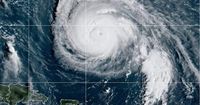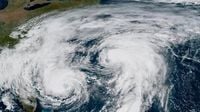Storm Amy, the first named storm of the 2025-2026 season, is barreling toward the United Kingdom, bringing with it warnings of fierce winds, torrential rain, and the threat of significant disruption across northern and western regions. The Met Office, the UK’s national weather service, has issued a series of yellow weather warnings in anticipation of Amy’s rapid development and landfall on Friday, October 3, 2025, with the storm expected to linger into Saturday, October 4.
According to the Met Office, Amy’s formation has been heavily influenced by the remnants of Hurricanes Humberto and Imelda, which have swept across the tropical Atlantic. The interaction of these hurricane systems has accelerated the Atlantic jet stream, resulting in a rapid intensification of Storm Amy—a process meteorologists call “rapid cyclogenesis,” or more colloquially, a “weather bomb.” Marco Petagna, a senior operational meteorologist at the Met Office, explained that this process involves the central pressure of a low-pressure system dropping by 24 millibars in 24 hours, dramatically increasing the storm’s ferocity.
The first impacts of Amy are already being felt, with Thursday, October 2, bringing a spell of wet and windy weather ahead of the main event. The Met Office has imposed a 31-hour yellow rain warning for western Scotland from 5pm on Wednesday until the end of Thursday, with a further 12-hour rain warning running from midday Friday to midnight. Rainfall totals could be extraordinary, with up to 50mm expected to fall in just nine hours over western Scotland. In fact, as Marco Petagna noted, “Ten inches of rain [are] not out of the question over the highest ground in western Scotland in the next few days... pretty incredible rainfall totals.”
But it’s not just rain that has forecasters and emergency services on high alert. Winds across northern and western parts of the UK are predicted to reach up to 80 mph, with even stronger gusts possible on exposed coasts and hills, especially in the North West. Inland, gusts of 50 to 60 mph are expected widely, and in some places, winds may briefly hit 70 mph. The Met Office’s deputy chief meteorologist, Tom Crabtree, emphasized the uncertainty in the storm’s exact track but warned, “The system will bring gale-force winds across northern and western regions, with gusts widely reaching 50 to 60 mph inland in northern Britain, and potentially reaching 70 to 80 mph in places, with even stronger gusts on exposed coasts and hills, mainly in the North West.”
The yellow wind warning stretches across Scotland, Northern Ireland, parts of north and northwest England, and northern Wales. In Northern Ireland, the warning is in effect from 4pm on Friday until 6am on Saturday, while in Scotland, North West England, and North Wales, the warning runs from 6pm Friday until just before midnight on Saturday. These warnings indicate a risk of damage to buildings, possible transport delays, and the potential for power cuts and loss of mobile phone coverage. The Met Office cautions that “injuries and danger to life could occur from large waves and beach material being thrown onto sea fronts, coastal roads, and properties.”
Parts of north Wales—particularly Conwy, Denbighshire, Flintshire, Gwynedd, and Anglesey—are expected to experience widespread gusts of 50-60 mph, with the possibility of even higher speeds in some areas. Heavy rain is likely for north Wales on Friday, and the Met Office has warned of the potential for damage to buildings, disruption to travel, and power outages. Residents are being urged to secure loose items outside their homes, check travel conditions before setting out, and prepare for possible power cuts by gathering torches, batteries, and mobile phone power packs.
Transport authorities are bracing for significant disruption. Martin Thomson from Transport Scotland highlighted the likely impact on the transport network: “Storm Amy is set to bring heavy rain and strong winds to parts of Scotland and we expect to see disruption to the transport network in the warning areas. The rain and wind will bring difficult driving conditions, such as reduced visibility and surface water, and are also likely to affect the ferry and rail networks, so it’s important to plan your journey ahead of time.”
For those considering travel, the RAC’s breakdown spokesman Simon Williams issued a stark warning: “The combination of high winds and rain will make driving treacherous. We strongly advise only making journeys that are absolutely essential. Anyone who has to brave the conditions in the worst-affected areas will have to contend with gale-force gusts, surface water that lengthens stopping distances and floods that pose a risk to life and could cause catastrophic vehicle damage. The strength of the wind will also inevitably lead to dangerous debris on the roads. Staying put until conditions ease is the best advice.”
The Met Office’s yellow warning system is designed to communicate the risk of severe weather to the public. While yellow warnings indicate that most people can go about their daily lives, they also serve as an alert that conditions could deteriorate quickly, with the potential for more severe impacts if the storm’s path or intensity changes. The Met Office advises the public to stay updated on the latest forecasts, as “weather warnings may change quickly.”
The naming of storms is not just about giving a potentially destructive force a pleasant-sounding moniker. Since launching the “Name our Storms” initiative in 2015, the Met Office, along with Ireland’s Met Éireann and the Dutch KNMI, has found that naming storms helps communicate risks more clearly to the public and government agencies, improving safety and preparedness. This year, “Amy” was the most popular female name submitted by the public for the 2025-2026 list, which runs from September to the following August, coinciding with the period when severe storms are most likely.
With Amy being the first named storm of the season, the next storm on the list will be called Bram. Last season saw six named storms, with Storm Floris being the most recent in August. The alphabetical list of storm names skips certain letters (Q, U, X, Y, and Z) and is drawn from public submissions across the UK, Ireland, and the Netherlands.
Storm Amy’s arrival coincides with ongoing impacts from Hurricanes Humberto and Imelda in the Atlantic. While Amy is a separate system, the influence of these hurricanes on the jet stream has been a key factor in her rapid intensification. Meanwhile, the Atlantic remains active, with Imelda expected to strengthen into a Category 2 hurricane and threaten Bermuda, while Humberto continues to churn east-northeast. The ripple effects of these storms have already been felt as far away as North Carolina’s Outer Banks, where homes have collapsed into the ocean due to strong waves, and in the Caribbean, where Imelda caused deadly flooding in Cuba and Haiti.
As the UK braces for Amy’s arrival, officials and meteorologists are urging the public to stay weather aware, heed warnings, and avoid unnecessary risks. With the potential for flooding, power outages, and travel chaos, Amy’s impact could be felt far and wide before the storm finally passes.






